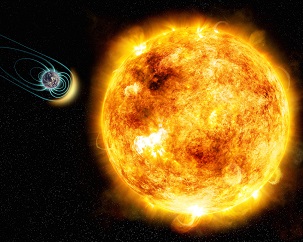
An artistic illustration. A CfA image
CAMBRIDGE (BNS): Life on Earth appeared some four billion years ago because the planet had a rocky surface, liquid water, and a blanketing atmosphere.
But life thrived thanks to another necessary ingredient: the presence of a protective magnetic field.
Studying a young, sun-like star named Kappa Ceti, located 30 light-years away in the constellation Cetus, a team of researchers has found that Earth's magnetic field played a vital role in making the planet conducive to life.
The star is remarkably similar to the Sun but is younger. Scientists have estimated its age to be around 400 to 600 million years old. This age roughly corresponds to the time when life first appeared on Earth.
Like other stars its age, Kappa Ceti is very active magnetically. Its surface is blotched with many giant starspots, like sunspots but larger and more numerous. It also propels a steady stream of plasma, or ionized gases, out into space.
The research team found that this stellar wind is 50 times stronger than our Sun's solar wind.
Such a fierce stellar wind would batter the atmosphere of any planet in the habitable zone, unless that planet is shielded by a magnetic field. At the extreme, a planet without a magnetic field could lose most of its atmosphere.
In our solar system, the planet Mars suffered this fate and turned from a world warm enough for briny oceans to a cold, dry desert.
The team modelled the strong stellar wind of Kappa Ceti and its effect on a young Earth. The early Earth's magnetic field is expected to have been about as strong as it is today, or slightly weaker. Depending on the assumed strength, the researchers found that the resulting protected region, or "magnetosphere," of Earth would be about one-third to one-half as large as it is today.
"The early Earth didn't have as much protection as it does now, but it had enough," says lead author Jose-Dias Do Nascimento of the Harvard-Smithsonian Center for Astrophysics (CfA) and University of Rio G. do Norte (UFRN), Brazil.
Kappa Ceti also shows evidence of "superflares" -- enormous eruptions that release 10 to 100 million times more energy than the largest flares ever observed on our Sun. Flares that energetic can strip a planet's atmosphere.
By studying Kappa Ceti, researchers hope to learn how frequently it produces superflares, and therefore how often our Sun might have erupted in its youth.
 Previous Article
Previous Article Next Article
Next Article













The Indian Air Force, in its flight trials evaluation report submitted before the Defence Ministry l..
view articleAn insight into the Medium Multi-Role Combat Aircraft competition...
view articleSky enthusiasts can now spot the International Space Station (ISS) commanded by Indian-American astr..
view article